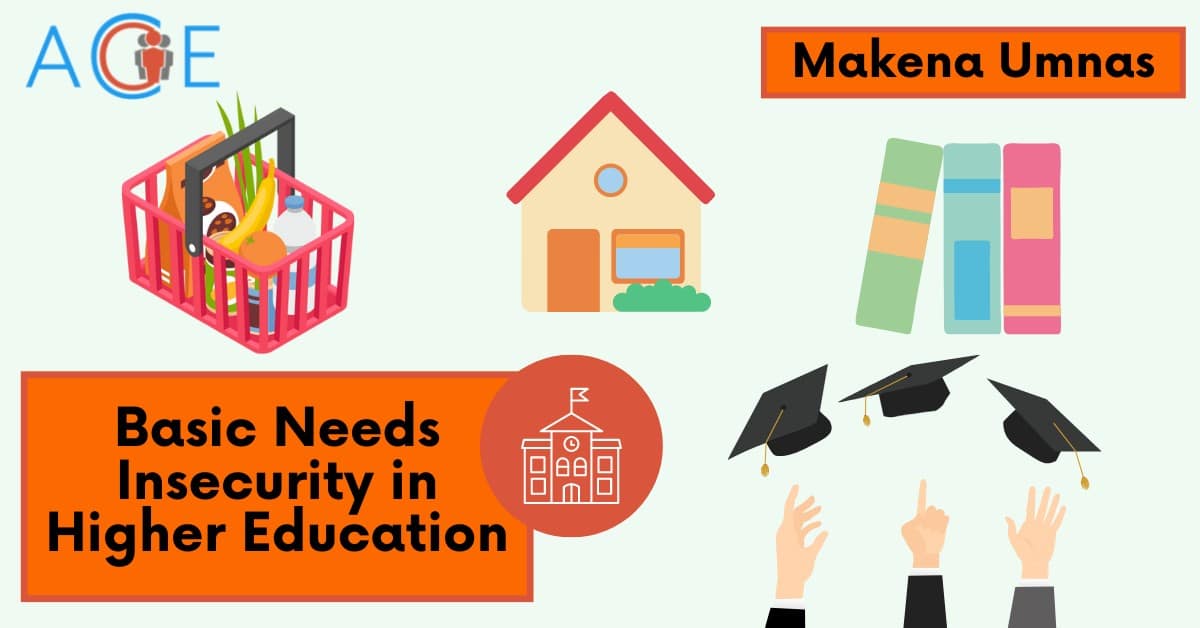Within higher education, many students face basic needs insecurities including insufficient food and housing. In the largest annual assessment of basic needs security amongst college students, results indicate that:
- 45% of respondents were food insecure in the prior 30 days
- 56% of respondents were housing insecure in the previous year
- 17% of respondents were homeless in the previous year
Additionally, of these respondents, only 20% of food insecure students receive the Supplemental Nutrition Assistance Program (SNAP), and only 7% of students who experience homelessness receive housing assistance. For students at both two- and four-year institutions, 75% of Indigenous students, 70% of Black students, and 64% of Hispanic or Latino students experienced basic needs insecurity, compared with 54% of white students.
Basic Needs for Postsecondary Student Program
The U.S Department of Education currently funds a program called the Basic Needs for Postsecondary Student Program. This program provides grants to eligible institutions of higher education, supporting programs that address the basic needs of students and ensuring practices that improve student outcomes are reported. These grants awarded have a performance period of 3 years and the projects implemented must take a systemic approach to improve outcomes for underserved students through coordinating efforts with Federal, State, or local agencies, or community-based organizations that support students.
For example, Passaic County Community College in New Jersey received one of these grants in 2021 to support the installation of a multicultural wellness and resource center. The project will provide basic needs services to 5,000 low-income, first-generation, minority students who also comprise underserved populations such as nontraditional adult students, parenting students, and undocumented students.
Introduced Legislation
There are a few proposed pieces of legislation coming from the Democratic Party circulating the House and the Senate. Two of these include the BASIC Act and the Student Food Security Act, both of which are currently under committee review.
The Basic Assistance for Students in College Act, or BASIC Act, was introduced to the Senate in 2019. It proposes a $1 billion grant program to help colleges and universities research, plan, and implement a basic needs infrastructure. The grant money could be used to provide free or subsidized food, offer temporary housing, help students apply for public assistance programs, or collaborate with community organizations.
The Student Food Security Act was introduced to the House in 2021. It proposes expanding SNAP eligibility to students who are eligible for work-study, have a $0 Expected Family Contribution, meet the financial eligibility criteria for a maximum Pell Grant (even if they have not filed the Free Application for Federal Student Aid (FAFSA)), or are an independent student whose household is otherwise eligible. It also creates a SNAP student hunger demonstration program that would allow students to use their SNAP benefits at on-campus dining facilities at up to ten institutions and establishes a $1 billion per year grant program to help institutions identify and meet the food and housing security of their students.
Arguments For Expanding Basic Needs Programs
Proponents of expanding basic needs programs argue there are record high numbers of low-income students enrolling in college to increase their chances of social and economic mobility. Concurrently, increased tuition costs and the student debt crisis make it difficult for low-income students to reach their aspirations. Food and housing insecurity undermine academic success, so expansion of basic needs programs will increase college completion rates, persistence, and credit attainment of low-income students. Senator Alex Padilla, a California Senator pushing for the BASIC Act to pass, emphasizes this by saying, “We cannot let our students go hungry or sacrifice their health in order to afford a higher education… The BASIC Act will help students focus on their goal – graduating. For these students to compete in a modern workforce we must give them the tools they need to succeed.”
Arguments Against Expanding Basic Needs Programs
Those against expanding basic needs programs argue there is currently limited research on basic needs insecurities on college campuses, so there is a limited understanding of the scope of the problem. Besides the annual survey previously discussed, only 31 quality studies of campus basic needs insecurity have been conducted, few of which involve multiple colleges.
Most proposed legislation lack support from conservative members of Congress. In 2020, Republican Rep. and top member of the House Agriculture Committee Michael Conaway shared he was opposed to increasing food stamp benefits during the pandemic, calling SNAP expansion a “backdoor way to get permanent changes.” He and other Republican officials believe that these programs foster long-term dependency on the federal government for low-income Americans. Many argue it is also not financially feasible to expand federal assistance. These proposed legislations both propose $1 billion grant programs and are extremely costly.



